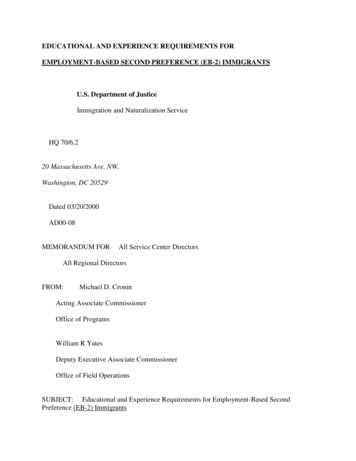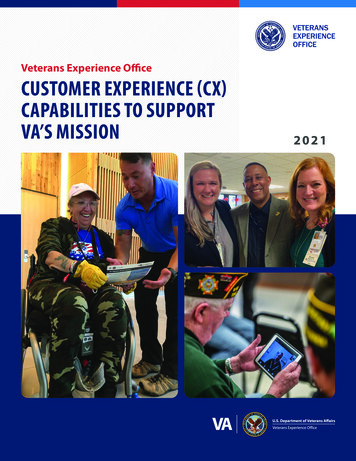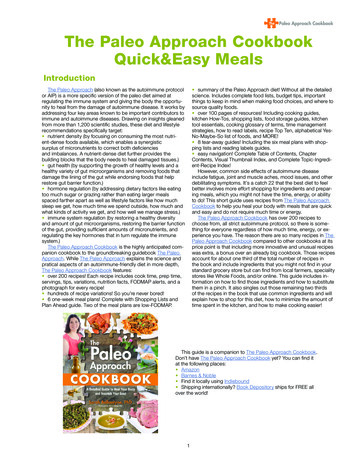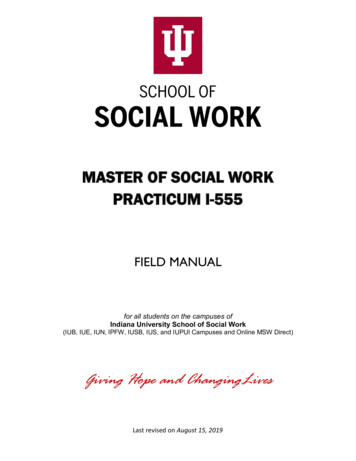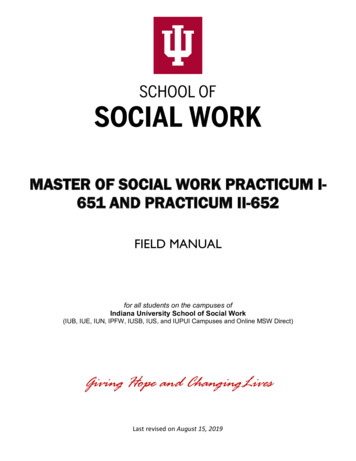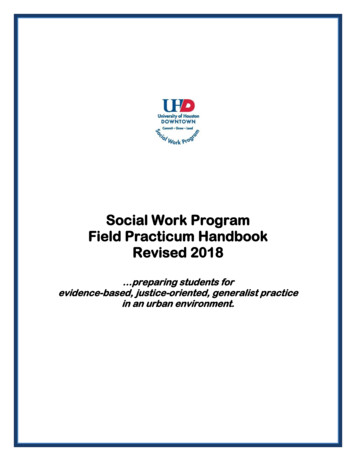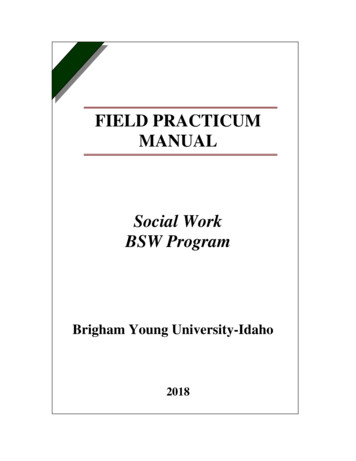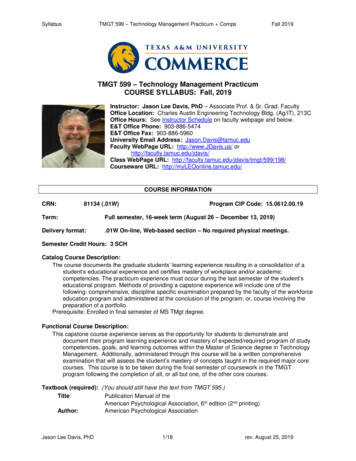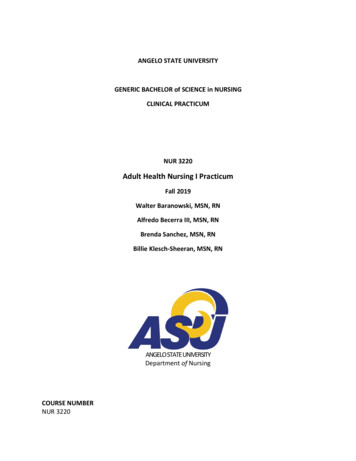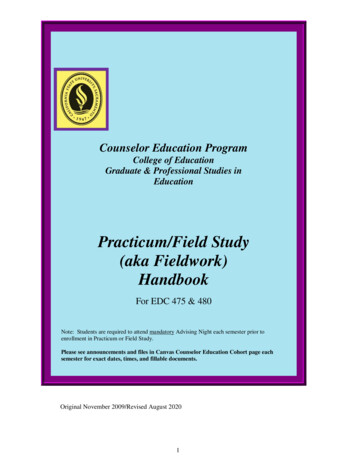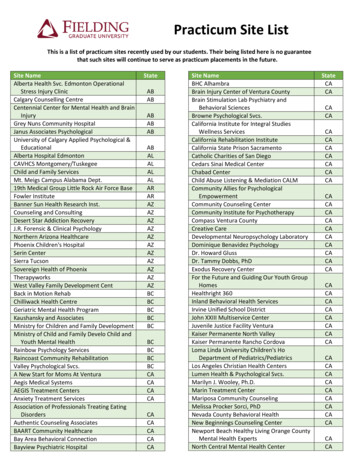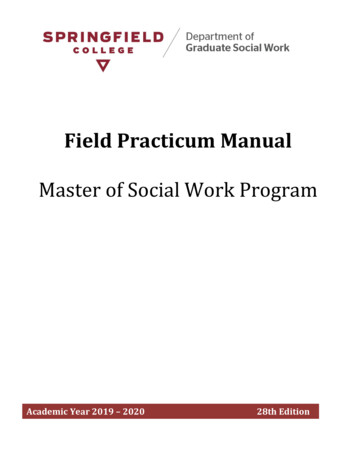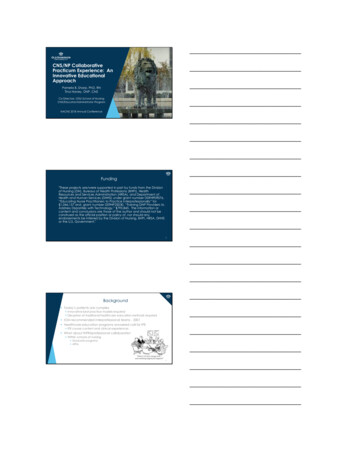
Transcription
CNS/NP CollaborativePracticum Experience: AnInnovative EducationalApproachPamela B. Sharp, PhD, RNTina Haney, DNP, CNSCo-Directors, ODU School of NursingCNS/Educator/Administrator ProgramNACNS 2018 Annual ConferenceFunding"These projects are/were supported in part by funds from the Divisionof Nursing (DN), Bureaus of Health Professions (BHPr), HealthResources and Services Administration (HRSA), and Department ofHealth and Human Services (DHHS) under grant number D09HP09076,“Educating Nurse Practitioners to Practice Interprofessionally” for 1,046,157 and grant number D09HP25030, “Training DNP Providers toAddress Disparities with Technology,” 793,845. The information orcontent and conclusions are those of the author and should not beconstrued as the official position or policy of, nor should anyendorsements be inferred by the Division of Nursing, BHPr, HRSA, DHHSor the U.S. Government."2Background Today’s patients are complex Innovative best practice models required Disruption of traditional healthcare education methods required IOM recommended interprofessional teams - 2001 Healthcare education programs answered call for IPE IPE course content and clinical experiences What about INTRAprofessional collaboration? Within schools of nursing Graduate programs APNs3
Traditional Graduate Nursing Programs Separate practicum courses & clinical sites by rolesDifferent & distinct objectives for clinical trainingLittle interaction for APN rolesFew academic intraprofessional collaborative opportunities“3-Ps” (Pharm, Patho, & Physical Assessment) Taken very early in the curricula Before formation of any professional identity Many offered via online or hybrid format Decreasing opportunities to develop understanding and appreciation: Other roles Responsibilities and scope of practice4CNS/NP Relationship APNs often work in silos rather than teams Function in parallel or direct competition Resulting in inefficient, costly patient care Lack of understanding of CNS role By healthcare providers & community members Adds to the divide5Benefits of CNS/NPCollaboration Distinct roles, share common goals Significant potential for improvingoutcomes for patients & populations Collaborative model: NP focuses on providing individualizedprimary care CNS partner focuses on coordination &transition of care Beneficial to: Rural & medically underserved clinics Patients with multiple chronic diseasesrequiring complex care coordination6
Intraprofessional Pilot Clinical PracticumExperience Fall 2015 Developed program for training & support of APN preceptors Improving APN preceptor skill Increasing student placements in rural & medically underserviced areas NP typically placed in rural & medically underserved areas CNS mostly placed in traditional urban acute care settings One-week training immersion experience NP/CNS student team paired in rural community-based clinic Two student volunteers 1 Family NP 1 Adult-Gero CNS/Educator Each completed 1 full clinical semester7Practicum Site Initial site: Dynamic community based medical homeInitiated by 2 NPs with deep ties to the communityTraditional ‘bricks & mortar’ community-based clinicIncluded mobile ‘health wagon’ Sophisticated diagnostic equipment Prepared to take health care to vulnerable members of community8Practicum Goals First goal: Expose students to innovative model of care Rural & medically underserved community-based clinic Second goal: Challenge student team to collaborate using new model Work together to improve patient care Expected to assess & develop one sustainable qualityimprovement project meet needs of the clinic’s population could be followed longitudinally by future student teams9
The Student Experience 8 hour drive across VA: Not intended to be part of learning experience Team reported: Engaging in rich dialogueCould not have been replicated in classroom or discussion forumGot to know each otherExplained unique preparation, competencies, and responsibilities of their rolesNP not fully aware of CNS competencies and preparation Despite years of experience as RN10The Student Experience Upon arrival at clinic: Able to identify different, yetcomplimentary, skills of theCNS and NP NP quickly began providinghigh level care focusing ondiagnosis, tx, healthpromotion & management CNS began analysis of clinic,community, & populationthat clinic serves11The Student Experience NP realized need for extended teaching Diabetes management and healthy living Most patients traveled over 1hour “off of the mountain” Unable to make frequent visits Medications and supplies to manage diabetes provided Patients unable to access healthy fruits and vegetables Closest grocery store over 1 hour12
The Student Experience Staff felt CNS should lead diabetes education program Beginning with phone contact to schedule education session 150 identified community members Student reached 7 able to come to clinic Student began conducting informal survey To determine why community members could not attend Common themes included: Need to care for family member Lack of transportation Conflicting work schedules13The Student Experience Student team identified typical wait time to see NP asopportunity for CNS to begin educating on: Disease management Healthy living Community resources “Tag-team” approach worked well CNS able to: Assist patient Gather valuable concise info during educational session Provide info to NP, aiding in facilitation of appointment14Outcomes Students reported: Increased levels of understanding of APN roles & scope of practice Experience was “invaluable” Exposed brokenness & great needs that exist within their own state Calling to return to clinic or similar settings upon graduation Volunteer basis15
Outcomes CNS student had not considered returning to rural roots: Articulated new desire to practice in rural community setting Original plan of working in urban acute care setting Experience enabled students to develop programs: Utilizing expertise inherent in each role Addressing pressing rural healthcare needs Several students since collaborated in clinical basedresearch projects16Conclusion and Next Steps Students & faculty realized richness of experience Outcomes could not have occurred withoutintraprofessional partnership Healthcare needs to embrace new models of care Intraprofessional work essential CNS/NP partnership can provide powerful vehicle for change17Conclusion and Next Steps Additional rural community-based settings located Each student must have at least 1 partneringexperience before graduation 1 team per semester Goal deliverable for each site Can be continued by next student team18
Lessons Learned Expensive funding needed Clinical sites must have clear understanding of each APN role Many rural community-based clinical sites do not have CNS preceptor Most are unaware of what role is & how CNS will benefit the clinic Faculty must invest time in visiting sites, face-to-face or virtually As each CNS/NP team travels to a new site, APN roles modeled bystudents Further educating providers in community19Remote Area Medical Clinic Experience Students submitted IRB application: Return to area during a RAM mission weekend Collect demographic data & info on how population wouldprefer to receive health information Determine needs as articulated by members of community Original 2 students joined by: Another CNS & NP student Interprofessional faculty led team Returned to collect data on over 220 patients2021
Remote Area Medical Clinic Experience Final data analysis still underway Preliminary data vast majority preferred writtenmaterial to take home vs. classroom or online Findings used by next student team to tailor aneducational program Fits the needs of the population based on interest &availability Student team & faculty published article in VNAquarterly newsletter22Intraprofessional Experience Implications Increase awareness of: APN roles Scope of practice Avenues for future collaboration Enable APNs to provide cost-effective, patient-centeredquality services23Intraprofessional Experience ImplicationsMeant to bridge healthcare gaps for vulnerable populationsMust be placed early in programsMust be focusedMay be expanded to include all APN student rolesSustainable model for intraprofessional advanced practice clinicaleducation Easily replicated by other schools 24
Questions?psharp@odu.eduthaney@odu.edu25
CNS/NP Collaborative Practicum Experience: An Innovative Educational Approach Pamela B. Sharp, PhD, RN Tina Haney, DNP, CNS Co -Directors , ODU School of Nursing . Staff felt CNS should lead diabetes education program B
